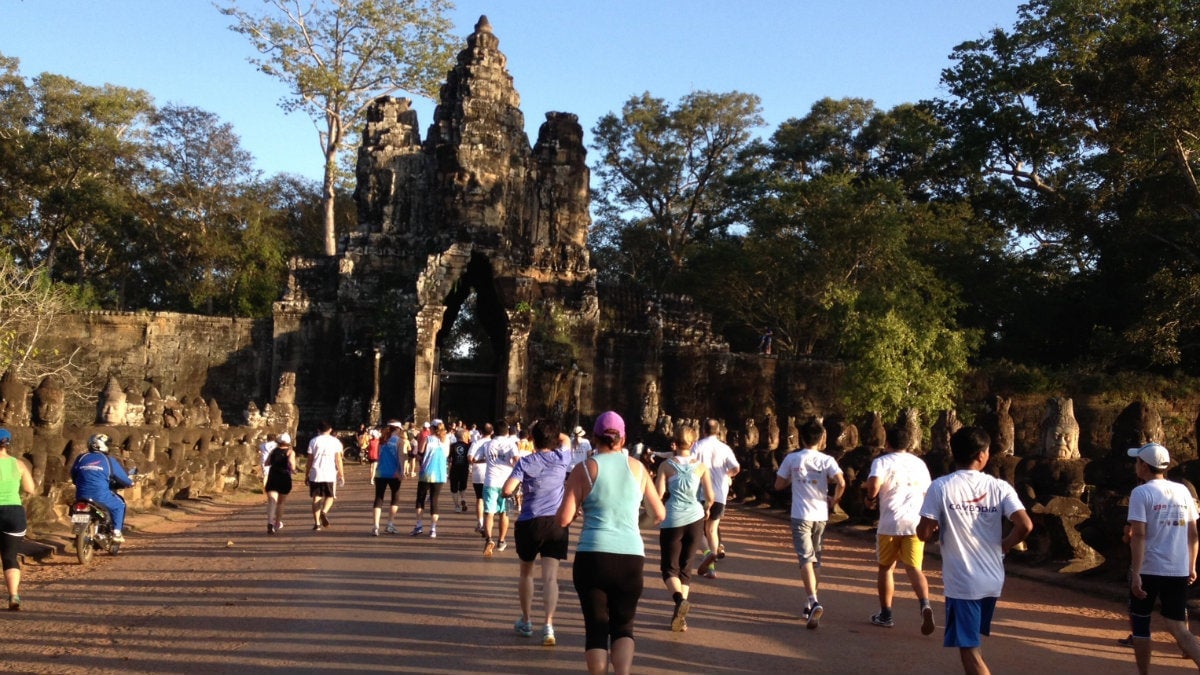Tuk-tuks, piles of mangoes and the Bayon Temple: A westerner’s experience running a 10K through Ankor Wat
Preparing for a race like the Great Wall Marathon outside of Beijing or the Angkor Wat half marathon in Siem Reap requires a certain ability to ignore reality. For instance, runners who train in Beijing rarely have the chance to jog outside, thanks to routinely unhealthy air quality. My gym in Beijing is overheated and noisy, with men puffing cigarettes inside the building while we pound along on treadmills and stare at CCTV on the television or MTVs “Teen Mom” on our iPads.

Preparing for a race like the Great Wall Marathon outside of Beijing or the Angkor Wat half marathon in Siem Reap requires a certain ability to ignore reality. For instance, runners who train in Beijing rarely have the chance to jog outside, thanks to routinely unhealthy air quality. My gym in Beijing is overheated and noisy, with men puffing cigarettes inside the building while we pound along on treadmills and stare at CCTV on the television or MTVs “Teen Mom” on our iPads.
This year’s Beijing Marathon, which I skipped, was scheduled on a day, Nov. 26, when the air in the city at 6 a.m. offered a fine particulate level of 390: “hazardous” by US Embassy standards.
And even without air pollution, many cities in Asia are just not equipped for runners, with traffic making something as simple as crossing the street a death-defying maneuver and sidewalks that disappear with no warning.
Add in Southeast Asia’s tropical heat or Inner Mongolia’s summer sandstorms, and you might wonder why anyone would bother with racing in Asia.
The answer lies in the pink and salmon sunrise coming up behind the ancient outlines of the temples at Angkor Wat. This kind of scene is the real draw for us adventure-travel runners, who use the excuse of a race to see a new place, even as we’re running past or through much of it, rather than lingering over every bas-relief.

The recent Angkor Wat race, which I participated in, was precisely that. As we jumped in tuk-tuks, motorcycles attached to rickety open-air carriages, and flew through a dark Siem Reap to get to the start, we saw fruit sellers unveiling piles of mangos and melons and women grilling tiny bananas on sticks by side of the road. Thousands of runners—both elite types who looked as fit and muscled as race horses and flabbier westerners wearing knee braces, milled around. Some of us nearly missed the start because we were too busy posing for pictures of ourselves in running gear in front of temples being lit by the sun.
Even in December, the day started warm. At a dinner for runners the night before, the race organizers warned: If you feel too hot, stop.
Despite the warnings, there were, inexplicably, runners in giant bear costumes, one fellow wearing a kilt below and a Santa costume on top, and a father pulling his child on a bike. The runners were from Japan, Hong Kong, Thailand, Sweden, America, Canada, Britain, Australia, and China, with many opting to walk at least part of the race, even though most of it was in shade and flat. Some runners did a 3K “fun run,” while others, like me, ran the 10K, and the truly dedicated runners did a half marathon, or 21K.
I stopped once for photos, asking a woman with an Irish group to take my photo in front of Bayon Temple. “You must be mad,” she said, staring at my beet-red face.
Along the route, brown-skinned children with bare feet stared at us and collected our empty water bottles for recycling, while pencil-thin adults, held back from their morning commute on bikes and motorcycles, watching with thinly veiled annoyance as runners of all size and shapes, but mostly with far more body fat than them, slogged past. We jogged slowly past ruins and working temples, with orange-robed monks lighting incense.
I paced myself behind a woman with the word “Kilimanjaro” tattooed in a curvy script on her back shoulder. At the very end, hearing the cheers of spectators, I sprinted past Kilimanjaro and dashed to the end.
At the finish, race organizers gave out cans of a sport drink, water, and bananas, while a band played “YMCA” with Cambodian lyrics, and hoards of tuk-tuk drivers waited in the shade to take the runners back to their hotels and guest houses. Next stop: Inner Mongolia.